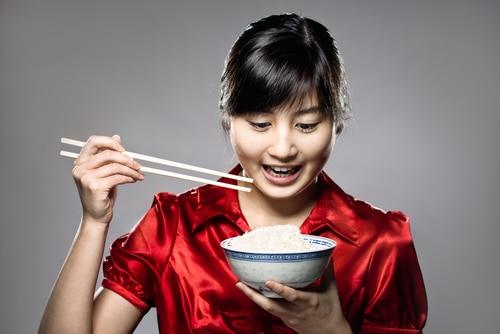
A Traditional Chinese Diet Emphasizes Vegetables
Chinese restaurants and buffets in the United States emphasize meat, but a traditional Chinese diet is heavier on the veggies. In fact, meat is more of a garnish than the main course in traditional Chinese homes. The Chinese fill their plates with an array of steamed or stir-fried vegetables including snow peas, Bok choy, broccoli, and greens. They enjoy servings of cruciferous vegetables like broccoli, greens, and Bok choy, also known as Chinese cabbage, almost every day. Cruciferous vegetables have the highest levels of cancer-fighting chemicals of any other type of veggie. Plus, veggies are rich in fiber and low in calories, which means they’re one of the best choices for controlling how many calories you take in at a meal.
The Chinese Don’t Eat Dessert
Unlike Americans, the Chinese don’t end their meal with a high-calorie dessert, although they may top off a meal with a sweet soup like a red bean, tofu or sweet almond soup. Although these soups aren’t free of sugar, they’re usually lower in calories than the doughnuts, cookies, and cakes many Americans eat after dinner. They’re also more likely to end the meal with fruit such as lychee rather than something that contains added sugar. Contrary to popular belief, the Chinese don’t eat fortune cookies that contain sugar and trans-fat.
There’s an Emphasis on Spices
Spices are an important part of Chinese cooking. One of the most common spices you’ll find in Chinese kitchens is five-spice powder, a spice that consists of fennel, peppercorns, cloves, star anise, and cinnamon. Both cinnamon and peppercorns have been linked with appetite and weight control benefits. Two other spices commonly used in Chinese cooking are chili powder and ginger. These spices add a more substantial flavor to foods, which makes them more filling. Spicy foods, in general, help to fill you up faster.
They Sip Green Tea
The Chinese have been sipping green tea for more than 3,000 years, and they usually enjoy it throughout the day. The catechins in green tea help to protect against a variety of age-related diseases and also modestly boost metabolism. Drinking several cups a day increases the number of calories you burn by about 85 calories a day. In contrast, the most popular drinks in America are sugar-sweetened colas or energy drinks. Calories you drink in liquid form count when it comes to controlling your weight.
The Pace of Meals is Slower
The Chinese don’t rush through meals the way people in Western countries do. Plus, they eat their food with chopsticks. This keeps them from taking large bites. Research shows that people eat fewer calories and feel fuller after a meal when they eat at a leisurely pace. People in Western countries are more likely to eat breakfast and lunch on the run and eat something convenient, regardless of how healthy it is.
The Bottom Line?
Try incorporating some of these Chinese diet and health practices into your own diet. Eat more vegetables and spices, sip green tea instead of sugar-sweetened drinks, slow down the pace of your meals and lighten up on the sweet desserts – then watch the pounds come off.
References:
Journal of the American Dietetic Association. Volume 108, Issue 7, Pages 1186-1191, July 2008.
5 Factor World Diet. Harley Pasternak, M.Sc. (2009)
Related Articles By Cathe:
Add This to Your Next Meal & You Might Make Healthier Food Choices
Dieting Around the World: Making French Cuisine Healthful & Delicious
Dieting Around the World: Making Thai Cuisine Healthful & Delicious
Dieting Around the World: Making Italian Cuisine Healthful & Delicious
Dieting Around the World: Making American Cuisine Healthful & Delicious

